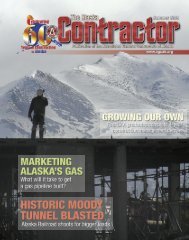The Alaska Contractor: Fall 2006
The Alaska Contractor: Fall 2006
The Alaska Contractor: Fall 2006
Create successful ePaper yourself
Turn your PDF publications into a flip-book with our unique Google optimized e-Paper software.
PUBLIC / PRIVATE<br />
partnerships f lourish<br />
H<br />
ypothetically speaking let’s say there is<br />
a big project out there; call it a highway.<br />
This project is sorely needed in a<br />
community where traffi c congestion is terrible<br />
and commuters are spending two to three hours<br />
a day in their cars traveling the 20 miles to<br />
work. Land is at a premium. <strong>The</strong>re are no roads<br />
that can be built because of a lack of available<br />
land.<br />
<strong>The</strong>re is another problem; money. Where<br />
will it come from? Who will pay for the existing<br />
two-lane highway to be upgraded to eight<br />
lanes? Taxpayers are strapped and unwilling to<br />
absorb a great tax burden. What can be done?<br />
Enter the private investor. This investor has agreed to<br />
partner with the state to redesign, build and operate a new<br />
road that will accommodate existing traffi c as well as the<br />
forecasted traffi c for the next 30 years.<br />
How does this happen? What is in it for the investor?<br />
With a little help from the state and a range of private<br />
funding sources, when fi nished, the private partner will reopen<br />
the project as a toll road allowing speedy payback to<br />
private investors and state backers while shortening commute<br />
times.<br />
Any money left over from loan repayment is considered<br />
surplus, which the private investor gets to keep. And thus<br />
puts money back in the pockets of investors to reinvest in<br />
the economy.<br />
Confused?<br />
Here is how it works.<br />
<strong>The</strong> National Council for Public Private Partnerships explains<br />
a public-private partnership as a contractual agreement<br />
between a private sector entity and a federal, state or<br />
local agency. Through this agreement, the skills and assets<br />
of the public and private sectors to the benefi t of the general<br />
public. Each party also shares in the project’s potential for<br />
risks and rewards.<br />
In essence public-private partnerships are a basic relationship<br />
between state or federal bodies and private companies.<br />
This relationship allows a private fi rm to design, build<br />
BY LAURA BRUCK<br />
and maintain a public infrastructure (such as a bridge, toll<br />
road, even a high school) while tapping into private and<br />
governmental resources.<br />
Such partnerships are developed to fund large projects<br />
that might not be practical with only public funding or with<br />
only private funding. It is an arrangement between private<br />
and public entities that can result in greater fl exibility and<br />
fi nancial freedom for both the private partner and the government<br />
body.<br />
Concerns for the growing amount of public debt in the<br />
1970s and 1980s prompted people to start looking for alternative<br />
ways to fi nance large projects. Governments both<br />
local and state were encouraging private investors to build<br />
public infrastructure.<br />
In a December 2004 report to Congress former U.S. DOT<br />
Secretary Norman Y. Mineta said “... [G]iven the fact that<br />
there are just limited fi nancial resources all the way around,<br />
I think the need for [public-private partnerships] is going to<br />
grow much more in the future. When you think about the<br />
amount of money that goes into research and development<br />
on specifi c transportation modes or when you think about<br />
the long timeline it takes in terms of trying to build infrastructure<br />
and especially where we’re trying to - lessen the<br />
gap between the demand for transportation and the ability<br />
of our transportation infrastructure to supply that demand,<br />
that it really requires public-private partnerships both in<br />
money, thought, and effort.”<br />
Private-public partnerships have been around for centuries.<br />
Many public works and projects all over the world have<br />
been built using this model.<br />
Projects such as the Royal Ottawa Hospital in Ontario,<br />
Canada, the National Maritime College of Ireland, the London<br />
Underground, and the Sydney Harbor Tunnel in Australia<br />
were all been built through such fi nancial partnerships.<br />
In the United States many notable projects have been<br />
brought to life, too, through such partnerships. Central Park<br />
in New York City, Downtown Chattanooga Redevelopment<br />
in Tennessee, Chicago Skyway Bridge in Illinois, Southern<br />
Indiana Toll Road from Martinsville to Evansville, Indiana,<br />
and State Route 125, which is under construction in Southern<br />
California.<br />
<strong>Alaska</strong>’s own Anchorage Museum began life as a publicprivate<br />
partnership. This coincided with the 100th anniversary<br />
of the purchase of <strong>Alaska</strong> from Russia.<br />
22 <strong>The</strong> <strong>Alaska</strong> CONTRACTOR <strong>Fall</strong> <strong>2006</strong>

















